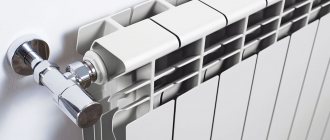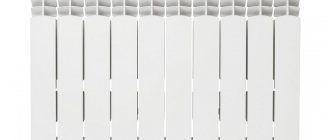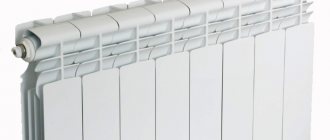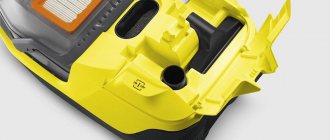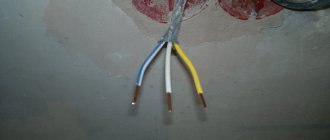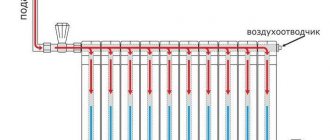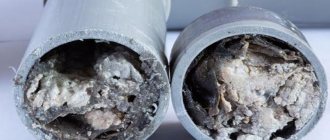Over time, private home owners inevitably notice that a well-functioning heating system begins to work less efficiently.
In most cases, the cause of poor heating of radiators is their clogging.
At the same time, energy costs are not reduced at all. The only way to solve this problem is to periodically flush the heating system.
Which batteries need to be washed?
All types of batteries require cleaning:
- Cast iron coolants often become clogged due to infrequent cleaning.
- A layer of rust settles in steel batteries, which significantly narrows the clearance for water passage and gradually corrodes the system.
- Plastic coolants also need care. The principles of washing plastic are slightly different from cleaning other types of coolants.
It's time to wash the batteries if:
- The radiator takes too long to warm up.
- The coolant segments are heated unevenly.
- Strange sounds during operation.
- Cold radiator (compared to the temperature of the central battery).
Poor performance of the coolant may also be caused by the formation of an air lock, to eliminate which it is enough to bleed air through the tap. If these measures are not successful, flushing the radiator of the heating system is required.
Briefly about the main thing
To maintain the efficiency of heating quality, a number of rules must be followed:
- Avoid using unprepared liquid as a coolant. In its simplest form, preparation involves boiling. This way the amount of salts is significantly reduced. But it is more effective to purchase specially created inhibitors that reduce the activity of corrosive processes. When choosing them, you need to make sure that the composition and material of the surfaces match.
- Know when heating systems are flushed and strictly follow the main steps.
- Coarse filters must be installed on heating lines. They are mounted in such a way that the pipe faces down. This will make it easier to clean, since all dirt is drained simultaneously with water.
- When choosing a contractor company, pay attention to companies that provide a guarantee for the activities carried out.
The heating system is cleaned by the company's professional staff within one day. Therefore, you should not neglect this service. The result will be a constant comfortable temperature in all rooms, as well as significant savings on heating.
Ratings 0
Mechanical flushing of coolant
Mechanical flushing is carried out by disassembling the heating elements. Dirt and deposits are effectively removed, but this method will not help against scale and corrosion. To carry out cleaning, the batteries are closed, removed, and the water is drained from the pipes.
The radiator is placed in the bathroom, having previously covered it with a cloth and closed the drain hole. Washing is done under a powerful stream of water.
Cleaning the cartridge filter
Such systems, often installed in country houses, are cleaned in a different way. You will need a filter key, a pan or bucket, a replacement cartridge or a container where you can clean the old one.
First, turn off the valve and make sure that there is no water left in the tap. Then place a bucket underneath: excess liquid from the flask will be drained there. Using a special wrench, you need to unscrew the nut and remove the flask. After this, you can either install a new cartridge, or thoroughly rinse and return the old one to its original place. Then the flask is returned to its place, the nut is screwed back in, and the water is turned on.
Not any cartridge can be reused: this option is only for wound ones. You can wash such a product using strong water pressure (it is recommended to use a hose for this).
Chemical battery flush
Chemical washing is carried out by pouring chemical reagents into the coolant. Flushing the heating radiator in an apartment is most often done using special mixtures. The method is effective and inexpensive.
- Flushing with a chemical composition is carried out both in summer and winter without stopping the main heating.
- Reagents remove rust and salt deposits. The composition of the chemical solution is selected taking into account the category of the radiator.
- The technicians shut off the battery, pump the chemical composition into the radiator, wait for the time allotted in the instructions, and then simply drain the liquid through the tap.
If the system is not pressed in, baking soda, whey, phosphoric and acetic acids are used for cleaning. The liquid for flushing heating radiators can be either alkaline or acidic.
When choosing a reagent, it is important to correctly calculate the time it remains inside the coolant to avoid damage to the battery. Chemical flushing is not suitable for aluminum radiators.
What will you need?
To flush your heating system yourself without disassembling the radiators, you will need specialized equipment (CIF), which is called cleaning in place. It is necessary for the pump to give direction to the movement of fluid in the system. The installation is a plastic container with a pump. In addition, you will need a cleaning solution. It will be poured into the tank and the system will be filled using a pump.
Such equipment is selected based on several factors.
- The cleaning system must be automatic with pulse control for flushing.
- The product body must be resistant to the use of various disinfectants.
- Size and weight are important, because with large dimensions it will be difficult to use the equipment. The optimal option will weigh 7-8 kg.
- It is desirable that the device has an indicator of water pressure and flow, and a flow reverse.
- The container should hold between 10-20 liters.
If you plan to mechanically clean radiators, you need to prepare containers for draining dirty liquid, unnecessary old rags that absorb moisture well, as well as polyethylene so as not to harm the floor covering at the cleaning site or while moving the radiator for washing. In addition, you will need keys, a gas burner or kerosene lamp, a hose to match the size of the heating pipe, a cleaning cable and an iron brush. When using the chemical method, you will need a reagent that does not destroy batteries, a compressor, or an apparatus for introducing liquid into the heating system. Choose a reliable machine; cost savings in this case may affect the quality of washing. This takes into account the type of cleaning material used.
Dispersed battery washing
Dispersed washing has a high-molecular effect on rust and other deposits. The solutions are harmless to people and metal elements.
Dirt, crushed into small pieces, is discharged through the drain, so pieces of dirt do not clog the radiator. After completing the treatment of the battery, a film is formed inside the pipes, preventing the accumulation of lime on the walls of the battery.
Washing is carried out as follows:
- Calculation of reagents is carried out.
- The radiator is being prepared.
- The coolant is connected to a pump, which will help introduce liquid into the system.
- Wait time (depending on the degree of clogging of the system and the choice of reagent).
- The waste liquid is drained into the sewer.
- Cleaning takes place in several stages.
How often does it need to be cleaned?
Due to water purification and retention of various debris, which does not disappear over time, it begins to accumulate. For this reason, over time, the water filter installed on the pipe becomes clogged. This leads to a decrease in water pressure, and over time, its complete absence. When such situations occur, it is necessary to clean the internal structural elements, for which the device should be removed, disassembled and washed.
Worth knowing! When the filter is sealed along with the water meter, you need to call a technician from the management company who will remove the seals. Once cleaning is complete, it is recommended to install a non-return valve, allowing cleaning to be carried out without the need to call a specialist further.
Hydrodynamic battery cleaning
Thin streams of water under pressure of several atmospheres are supplied to the system using a pump and hose nozzles. It is impossible to carry out hydrodynamic cleaning of batteries without special equipment: the help of specialists is required.
However, this method is the most environmentally friendly and most effective for cast iron.
The price for flushing heating radiators is very high, since at the initial stage the deposits are softened with a chemical composition, and only then the pipes are cleaned with a pump.
Conclusions and useful video on the topic
Video #1. The effectiveness of using hydropneumatic radiator flushing can be assessed by the amount of dirt thrown out:
Video #2. The subtleties of performing a chemical type of flushing of the heating system are outlined in the following story provided by the owner of a private household:
Any of the considered options for flushing heating systems does not represent an overly complicated procedure. If you have some experience in plumbing work and, in some cases, special equipment that can be rented, you can perform this operation yourself.
Would you like to talk about the effectiveness of flushing or tell us how you flushed the heating circuit in your home? Do you have valuable recommendations or important nuances that you would like to share with site visitors? Please write comments in the block form below.
Hydropneumatic battery cleaning
The heating circuit is purged by a powerful compressor. Build-ups and deposits under the influence of high pressure are torn off the walls of the battery and washed out through a hose lowered into the sewer.
Flushing a heating radiator without removing it is a convenient and effective way to clean the coolant. Washing takes only a few minutes. Pulse impacts are carried out in several stages with short intervals, destroying deposits and bringing them out.
Signs of scale on the inner surface of pipes
It is possible to determine excess scale accumulation by monitoring the system or in the presence of several indirect factors:
- Significant increase in energy consumption and resources for heating the room.
- Temperature difference between batteries and riser.
- Radiators heat up unevenly, this is especially noticeable on the upper and lower parts of the devices.
- When the heating element is operating, noise (especially crackling) is heard.
- The time required to heat up the heating system increases significantly.
Often the appearance of contamination is accompanied by the replacement or addition of radiators.
Electrohydropulse technique for washing batteries
During flushing, electrical pulse energy is used to destroy salts and rust inside the pipes.
- It is possible to carry out electrohydropulse cleaning of batteries without removing the elements.
- At the end of the process, the coolant is washed with ordinary water for final cleaning of contaminants.
The method is suitable for batteries of any configuration. The system allows the batteries to return to the factory pipe cross-section, since all deposits are removed almost completely.
Ready solutions
GEB G30 Desembuant
The product can be used not only in metal, but also in plastic pipelines. 1 liter of solution is designed for 100 liters of coolant.
Price: $14.
GEB G30 Desembuant
pros
- suitable for plastic pipes;
- compatible with underfloor heating systems;
- small expenditure of funds.
Minuses
- high price.
HeatGUARDEX Cleaner 808R
A product based on hydrochloric acid is designed to combat long-term deposits older than 3 years. The manufacturer promises that flushing with the drug will extend the life of the heating system by 10 years. 1 liter of the drug is designed for 100 liters of coolant.
Price: 3990 rub./l.
HeatGUARDEX Cleaner 808R
pros
- easy to use;
- effective in combating heavy pollution.
Minuses
- not identified.
Filter materials for water treatment systems HeatGUARDEX Cleaner 808R
Self-flushing of coolant
Experts recommend washing the batteries in the house before the start of the heating season, but after purging the circuit. Otherwise, dirt from other radiators will quickly enter the battery from other apartments. It is enough to clean radiators once every 3 years.
It is recommended to clean cast iron batteries only after the end of the heating season, since the material is very sensitive to temperature changes.
In a private house where water for heating is taken from wells, it is necessary to clean the circuit. It is enough to turn off the boiler and bleed air from the system. A radiator flushing method is selected that is suitable for the type of battery, and the entire heating system is cleaned.
At home, to increase efficiency, it is recommended to use special reagents. The battery is removed, placed in the bathroom, washed with running water, shaking and tapping the walls.
The largest particles of deposits come out after the first wash. Then, for several hours, chemicals are poured into the heating element, which can almost always be found in the house:
- Hydrogen peroxide (cleans and disinfects pipes). To clean, peroxide is poured directly into the pipe;
- Citric acid (eliminates odors). Prepare a solution of 3 tsp. per glass of water;
- Baking soda (2 tbsp per 3 liters of water).
Flushing heating radiators is a technically simple process that can be done at home. However, you can always turn to specialists.
Frequency of cleaning the heating system
Poor heating of the batteries and extraneous sounds during their operation are the most common signals about the need to clean the pipelines. The frequency of this procedure depends on the following factors:
- temperatures during system operation;
- composition of the liquid flowing through the system;
- battery materials;
- pipeline materials.
The first cleaning is carried out immediately after the installation work on the pipeline and radiators. Further, the frequency of flushing the heating system, according to the standards, is as follows:
- for PVC products once a year before starting the boiler;
- for iron products - before and after the operation of pipes and radiators.
The choice of cleaning option depends on the materials used, as well as the overall operating period of the heating devices. Proper flushing of the heating system, regulatory documents and procedure are specified in SNiP 3.05.01-85.
Timely cleaning of pipes will preserve the integrity of individual elements of the system Source ytimg.com
Photo of flushing heating radiators
Reticulate
The mesh device is a housing with a mesh filter inside. The most popular option looks like a piece of pipe with a diagonal “spout” (bend), at the end of which there is a screw-off plug. Water, passing through the mesh, leaves suspended matter in it and then goes into the purified system.
From time to time you have to unscrew the plug and remove the filter mesh for washing. Then everything is put back in place, and the device itself does not need to be removed from the pipe. This is the so-called flushing threaded mud sump, but there are many more different types.
According to the type of self-cleaning, the mesh filter can be:
- non-flush - rinsing is carried out after removing the device and disassembling it;
- flushing - to clean, just unscrew the plug and remove the mesh;
- self-flushing - dirt is removed from the mesh by a water flow from the opening of a special drain valve.
Depending on the mounting method, coarse filters differ in:
- welded;
- threaded;
- flanged.
Most heating models have an additional mesh to separate air from the water flow. When it accumulates excessively at the top of the mud trap, the float is activated, and the needle valve allows the gas to exit the device.
The effectiveness of the mesh option directly depends on the smoothness of the increase in hydraulic resistance in the system, both before and after it. Constant changes in pressure in the pipes can cause dirt particles to be forced through the mesh.
You can track the degree of contamination of the mesh by constantly removing it and visually checking it. Or install pressure gauges on both sides of the sump tank and use their readings to monitor how dirty the filter is. There are also variations with a glass bulb for visual inspection.
